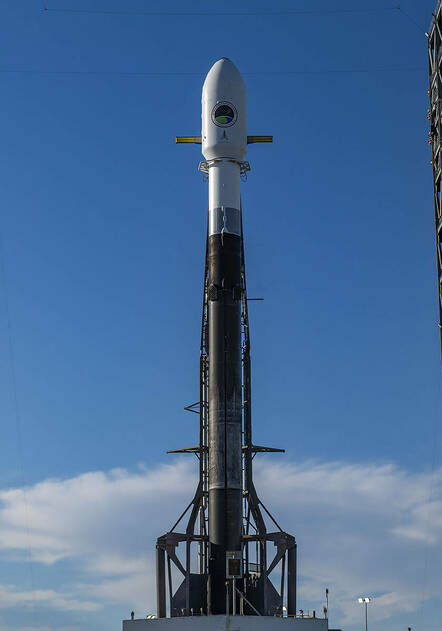BOOK THIS SPACE FOR AD
ARTICLE ADLast night's launch of six Pentagon missile-detection satellites was well timed as fears mount that Russia is considering putting nuclear weapons into space.
The US Department of Defense confirmed its payload included two satellites for the Missile Defense Agency's (MDA) Hypersonic and Ballistic Tracking Space Sensor (HBTSS), and the final four Tranche 0 satellites for the Space Development Agency's (SDA) Proliferated Warfighter Space Architecture (PWSA) communications constellation.
American defense contractor L3Harris, which designed five of the six satellites, said the launch, using a SpaceX Falcon 9 rocket, was a success. The other satellite, a second HBTSS unit, was built by Northrop Grumman.
"This launch represents a pivotal time for MDA as we enter a new phase of missile warning, tracking and defense," said MDA director Lieutenant General Heath Collins. "These HBTSS satellites are an essential step forward in our efforts to stay ahead of our adversaries."
The SpaceX Falcon 9 rocket that took six Pentagon missile-tracking satellites to orbit yesterday ... Source: SpaceX/US DoD
An MDA spokesperson told The Register the two HBTSS satellites launched yesterday are the only two planned for the program.
Yesterday's launch brings the total number of PWSA satellites to 27, all of which form of the first layer of the military's missile tracking and data transport kit, a.k.a. Tranche 0. Launch of those satellites began in April of last year after a number of delays in the program.
Tests of the PWSA tranche 0 satellites, which was supposed to take place over the summer last year, only happened in late November due to concerns from the US Federal Aviation Administration that downlinks from the constellation to Earth could cause dangerous interference for aircraft and ground-based receivers.
The National Telecommunications and Information Agency issued a waiver for the tests, but only over international waters and on the ground in an unnamed Five Eyes country.
The PWSA constellation will eventually feature as many as four tranches and hundreds of satellites, which will add progressively more capabilities to build a space-based communications network for US military. Along with missile tracking, PWSA satellites will provide targeting of objects beyond line-of-site, low-latency data links, improved positioning and navigation services, and encrypted communications.
Satellites for Tranche 1 of the PWSA are being constructed now, we're told, and are scheduled for launch later this year.
The pair of HBTSS satellites, on the other hand, are a "space sensor prototype demonstration providing fire control quality data required to defeat advanced missile threats," the Pentagon said yesterday. The missile sensors in HBTSS satellites are also different from those onboard PWSA sats, which SDA director Derek Tournear said will give the Defense Department improved threat visibility.
"In Tranche 1 [of PWSA], SDA will fly both sensor types as an operational system – medium-field-of-view demonstrating fire control, based on HBTSS design, and wide-field-of-view doing warning and tracking, based on T0 tracking design," Tournear said.
"Following the successful demonstration of HBTSS capabilities, the responsibility for HBTSS operational fielding will be transferred to [the US Space Force] and MDA will continue the development of the next generation of space-based fire-control sensors for missile defense," an MDA spokesperson told us.
But can they stop space nukes?
US House Intelligence Committee chairman Mike Turner (R-OH) made a cryptic statement yesterday alluding to a "serious national security threat." Reports have claimed Turner was referring to Russian plans to develop and deploy some kind of space-based nuclear weapon, though it's not entirely clear that's actually the case.
Reports have indicated the Russian weapon would be designed to take out other satellites, and while Turner has urged President Biden to declassify all information regarding the threat to enable open discussion of a solution, other parties are urging calm and saying the potential weapon isn't necessarily a threat.
Report reveals US Space Force unprepared to counter orbital threats US amends hypersonic weapons strategy: If you can't zoom with 'em, boom 'em Russia says Starlink satellites could become military targets US Space Force finally creates targeting unit – better late than never, right?While describing it as significant, House representative Jim Himes (D-CT) said there "is no cause for alarm or panic," and it's "like intelligence we see a couple times a month."
If accurate, however, it would put Russia at odds with the 1967 Outer Space Treaty, which states that signatories "shall not place nuclear weapons or other weapons of mass destruction in orbit." The pact was signed by the Soviet Union, and is recognized by Russia. The Kremlin has already tested ground-launched missiles to destroy its own satellites, though not nuclear ones – and not ones that would be launched from space.
Russian officials denied the anti-sat space nuke claims, with Kremlin spokesman Dmitry Peskov calling it a ploy by the White House to get Congress to approve funding for Ukraine's fight against Russia's 2022 invasion of the country.
"It is obvious that the White House is trying, by hook or by crook, to push Congress to vote on the bill to allocate money," Peskov told Russian news agency TASS. "We'll see what tricks the White House will resort to."
The US Senate has approved a $95 billion bill to provide defense assistance to Ukraine, Israel, and Taiwan, but House speaker Mike Johnson (R-LA) said yesterday he has no plans to bring the bill to an immediate vote in the House. ®
.png)
 9 months ago
51
9 months ago
51 















 Bengali (Bangladesh) ·
Bengali (Bangladesh) ·  English (United States) ·
English (United States) ·